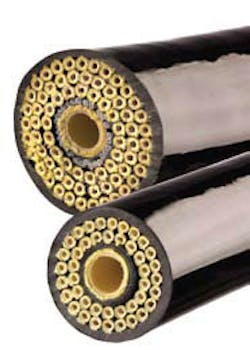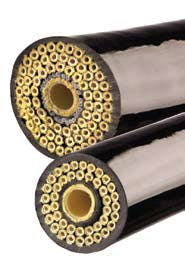Getting that Really Deep Oil is the Challenge
The world is not running out of oil, it’s running out of easily found and easily extracted oil. What’s left is in places that are hard to get to and even harder to work in, like ocean depths. Only a few years ago, working in 6500 ft of water was the industry’s “stretch goal.” Today, the new frontier starts at 10,000 ft.
At those depths, even simple tasks like delivering hydraulic fluid or electrical control signals require highly engineered solutions. For example, at 10,000 ft, the pressure is nearly 2.25 tons/in.2 Designing a hose that can withstand that much crushing force and still remain flexible — as well as handle internal pressures of 15,000 psi or more — is no simple task.
“The subsea exploration and production industry uses different kinds of hoses,” explains Mike Rauh, Eaton Corp.’s senior product manager. Two popular choices are blowout prevention (BOP) pod hose bundles and high crush resistant (HCR) hose.
“One thing you absolutely must avoid in any kind of drilling, but especially underwater, is a ‘blow out’,” says Rauh. “Imagine a drilling rig suddenly enveloped in a gigantic bubble of extremely flammable gas and you will immediately understand the safety impact of reliable blowout prevention.”
That nightmare scenario is what could happen if the drill string penetrates a high-pressure gas pocket. To prevent it, every wellhead has a BOP stack equipped with quickreacting hydraulic rams that can be closed to prevent the escape of high-pressure gas.
The BOP stack is powered and controlled from the surface using a highly specialized BOP pod hose bundle. It consists of a central high-pressure hose that supplies fluid to the BOP accumulator, surrounded by a cluster of smaller hoses that carry control signals to and from the wellhead.
“We have the ability to produce virtually any combination of high-pressure hoses up to 15,000 psi, HCR hoses, electrical cables, and/or fiber optics in lengths of 9,000 ft or more for the control needs of subsea production,” Rauh says.
One advantage of such bundles is the ability to deliver hydraulic fluids, process chemicals, electric power, and data communication capabilities in a single assembly. A typical example is the use of Synflex HCR in umbilicals to inject methanol into the production stream to control parafin and hydrates in underwater flow lines.
The demands of deep water production and higher hose performances are so immediate, Rauh says, “that one of our major customers purchased our entire initial production run of our new 7500 psi, -inch diameter HCR hose for their West African operations before we had even finished manufacturing it.”
For more information, visit www.eaton.com/hydraulics.

